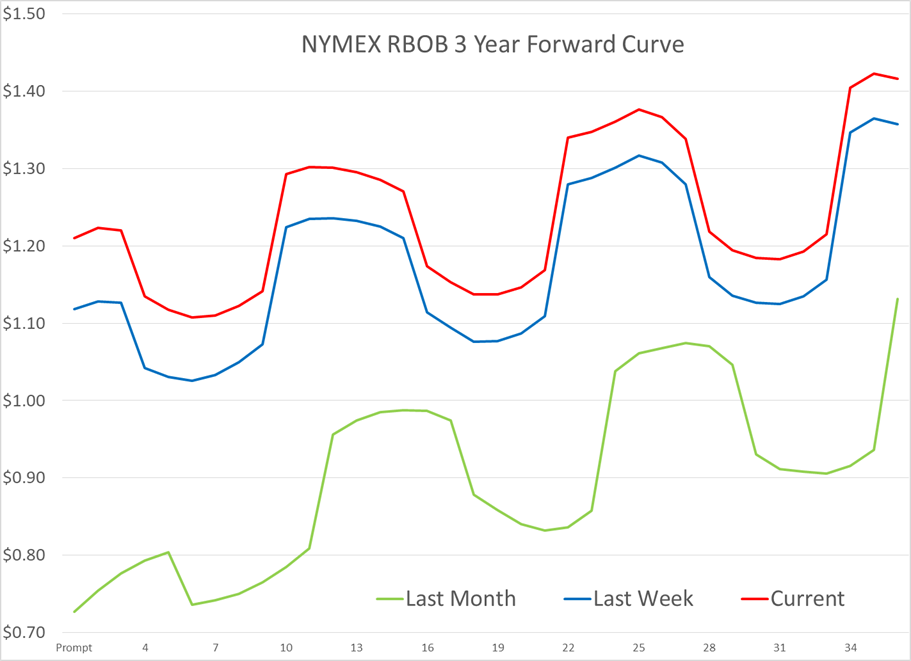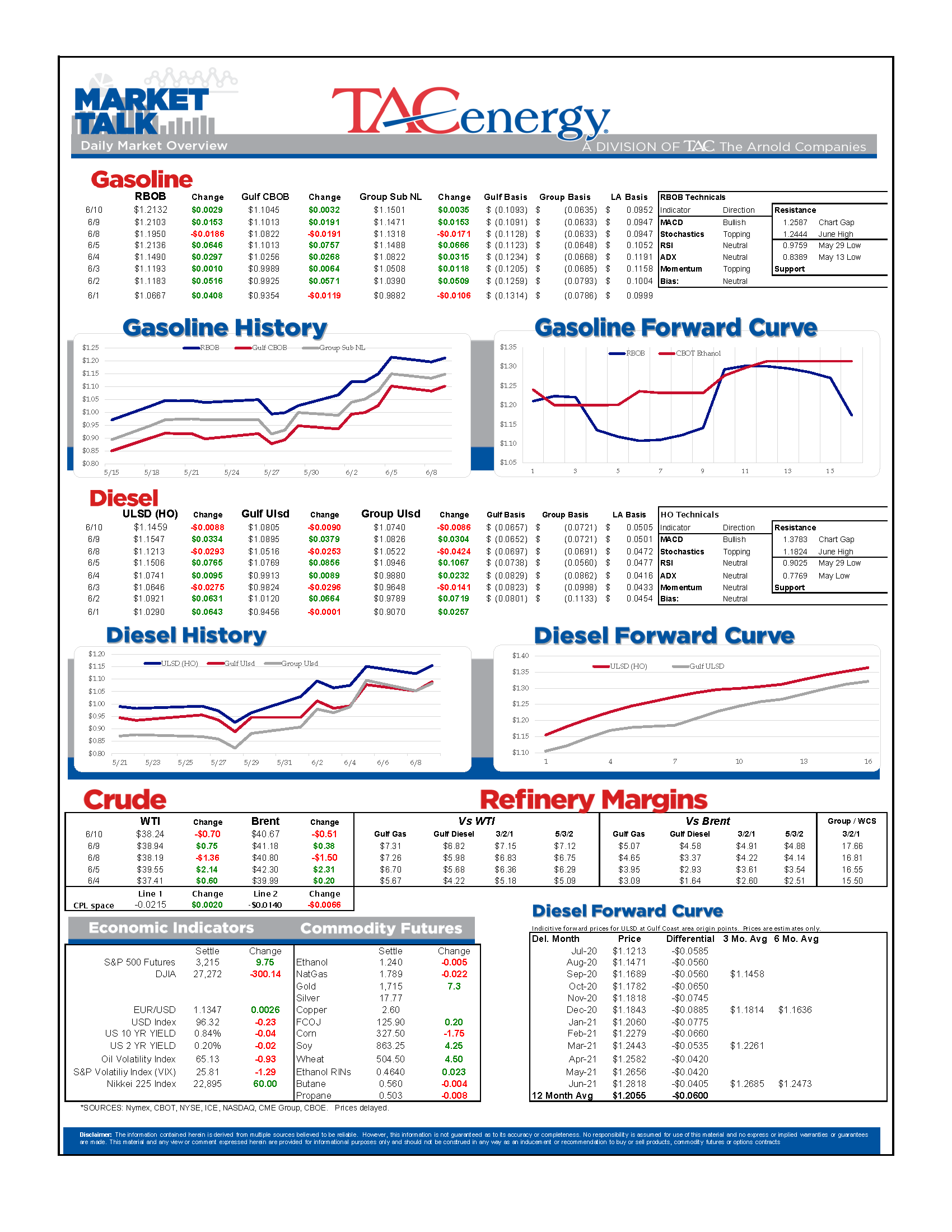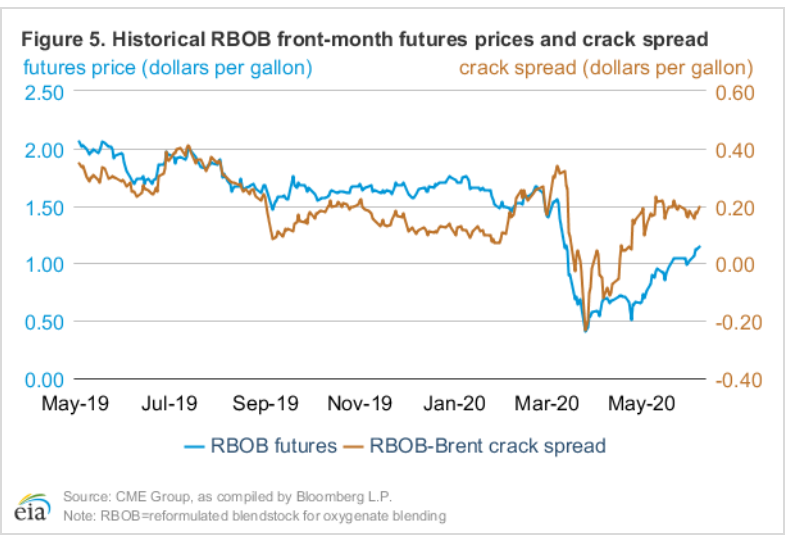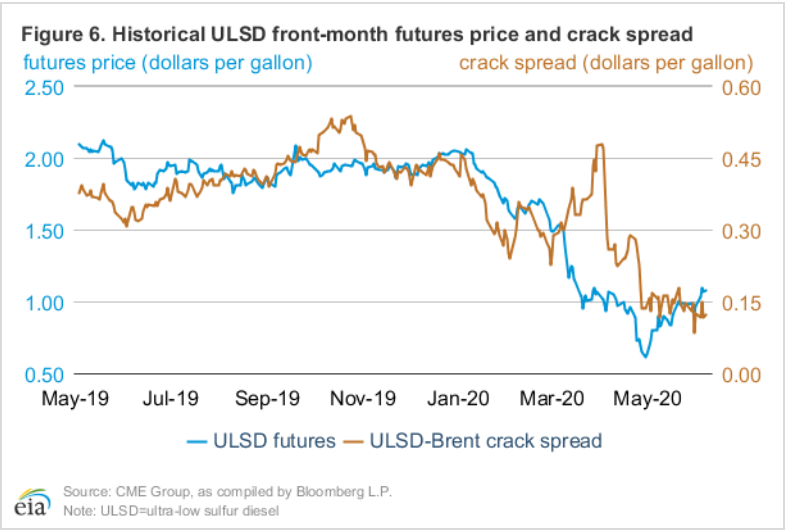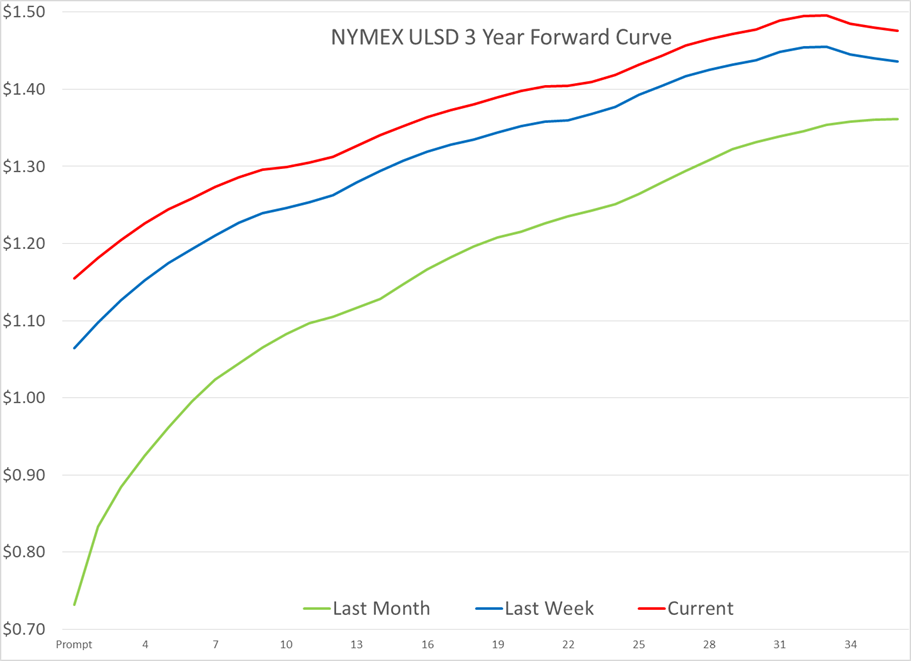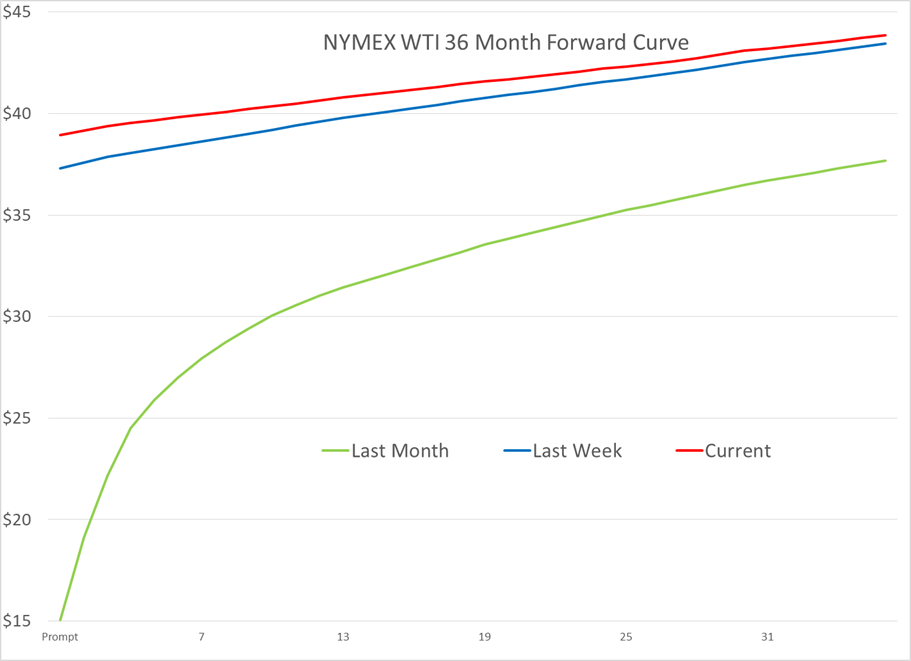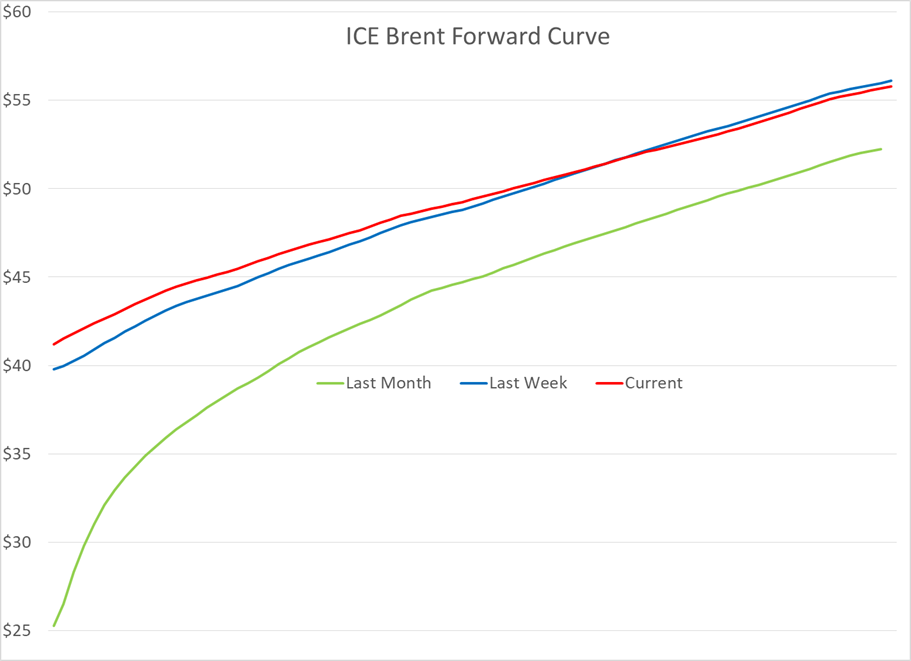Late Rally Pushes Prices Into The Green

After a late rally that pushed prices into the green after trading lower most of the session, energy futures are coming under pressure once again after more inventory builds check the optimism for economic recovery. The price action in the back half of the week looks to be pivotal from a technical perspective, as the recent selling has contracts testing their upward sloping trend lines,. Whether or not that support holds up may mean the difference in another large rally or a substantial correction lower.
The API was said to report another large build in U.S. oil stocks of more than eight million barrels last week, while distillates had another build of 4.3 million barrels, and gasoline stocks declined by 2.3 million barrels. The increase in crude oil was almost all in PADD 3 – likely driven by the spike in Saudi imports offloading along the gulf coast – while Cushing, OK inventories had another large decline of more than two million barrels. If the API estimates carry over to today’s DOE report, we will see U.S.diesel inventories reach an all-time high.
The EIA’s Short Term Energy Outlook painted a more optimistic outlook for the industry, which seemed to encourage Tuesday’s late bounce, suggesting the glut of global fuel inventories would start being reduced this month as demand recovery has been better than previous forecasts. The report also highlighted the stark difference in gasoline and diesel cracks during this recovery – consistent with what the weekly inventory reports have been showing - which could limit refiner’s ability to recover from this crisis.
The FOMC will make a policy statement this afternoon, and will release its economic forecast and host a virtual press conference. While most predictions suggest there will be no new policy announcements today, watch for language about Yield Curve Control, to become more commonplace in coming weeks.
Speaking of forward curves…the charts below show how quickly the energy forward curves have moved away from the super contango witnessed in the past couple of months, which should help encourage some barrels to be pulled from storage as long as the slow and steady demand recovery continues. Distillates still seem the most susceptible to pressure on the curve as the demand recovery hasn’t kept pace with the rapid increase in inventories and tankage is becoming scarce.
Notes from the STEO:
EIA now expects global oil inventories will begin declining in June, a month earlier than previously forecast, with draws continuing through the end of 2021. The sooner-than-expected draws are the result of sharper declines in global oil production during June and higher global oil demand than previously expected.
Declines in U.S. liquid fuels consumption vary across products. EIA expects jet fuel consumption to fall by 64 percent year-over-year in the second quarter of 2020, while gasoline consumption falls by 26 percent and distillate consumption falls by 17 percent. EIA forecasts the consumption of all three fuels to rise in the third quarter and into 2021 but to remain lower than 2019 levels.
After decreasing by 2.8 percent in 2019, EIA forecasts that U.S. energy-related carbon dioxide (CO2) emissions will decrease by 14 percent (714 million metric tons) in 2020.
Click here to download a PDF of today's TACenergy Market Talk.
Latest Posts
Week 16 - US DOE Inventory Recap
Energy Markets Trading Quietly In The Red As Ethanol Prices Rally To Five-Month High
The Struggle For Renewable Producers Continues As A Rapid Influx Of Supply And Crashing Credit Prices Make Biodiesel
After Years Of Backwardation, Diesel Prices Have Slipped Into Contango Over The Past Week
Social Media
News & Views
View All
Week 16 - US DOE Inventory Recap

Energy Markets Trading Quietly In The Red As Ethanol Prices Rally To Five-Month High
Energy markets are trading quietly in the red to start Wednesday’s session after a healthy bounce Tuesday afternoon suggested the Israel-Iran-linked liquidation had finally run its course.
There are reports of more Ukrainian strikes on Russian energy assets overnight, but the sources are sketchy so far, and the market doesn’t seem to be reacting as if this is legitimate news.
Ethanol prices have rallied to a 5-month high this week as corn and other grain prices have rallied after the latest crop progress update highlighted risks to farmers this year, lower grain export expectations from Ukraine, and the approval of E15 blends this summer despite the fact it pollutes more. The rally in grain and renewables prices has also helped RIN values find a bid after it looked like they were about to test their 4-year lows last week.
The API reported small changes in refined product inventories last week, with gasoline stocks down about 600,000, while distillates were up 724,000. Crude oil inventories increased by 3.2 million barrels according to the industry-group estimates. The DOE’s weekly report is due out at its normal time this morning.
Total reported another upset at its Port Arthur refinery that’s been a frequent flier on the TCEQ alerts since the January deep freeze knocked it offline and damaged multiple operating units. This latest upset seems minor as the un-named unit impacted was returned to normal operations in under an hour. Gulf Coast basis markets have shrugged off most reports of refinery upsets this year as the region remains well supplied, and it’s unlikely we’ll see any impact from this news.
California conversely reacted in a big way to reports of an upset at Chevron’s El Segundo refinery outside of LA, with CARBOB basis values jumping by more than a dime. Energy News Today continued to show its value by reporting the upset before the flaring notice was even reported to area regulators, proving once again it’s ahead of the curve on refinery-related events. Another industry news outlet meanwhile struggled just to remember where the country’s largest diesel seller is located.
Click here to download a PDF of today's TACenergy Market Talk

The Struggle For Renewable Producers Continues As A Rapid Influx Of Supply And Crashing Credit Prices Make Biodiesel
The sigh of relief selloff continues in energy markets Tuesday morning, with gasoline prices now down more than 20 cents in 7 sessions, while diesel prices have dropped 26 cents in the past 12. Crude oil prices are within a few pennies of reaching a 1 month low as a lack of headlines from the world’s hot spots allows some reflection into the state of the world’s spare capacity for both oil and refined products.
Gasoline prices are trading near a 6-week low this morning, but still need to fall about another nickel in order to break the weekly trendline that pushed prices steadily higher since December. If that trend breaks, it will be safer to say that we saw the end of the spring gasoline rally on April 12th for the 2nd year in a row. Last year RBOB futures peaked on April 12 at $2.8943 and bottomed out on May 4th at $2.2500. The high (at this point) for this year was set on April 12th at $2.8516, and the low overnight was $2.6454.
It’s not just energy commodities that are seeing an unwind of the “flight to safety” trade: Gold prices had their biggest selloff in 2 years Monday and continue to point lower today. Just how much money poured into commodities in the weeks leading up to the direct confrontation between Israel and Iran is unclear, but we have seen in year’s past that these unwind-events can create a snowball effect as traders can be forced to sell to cover their margin calls.
Supply > Demand: The EIA this morning highlighted the record setting demand for natural gas in the US last year, which was not nearly enough to offset the glut of supply that forced prices to a record low in February. A shortage of natural gas in Europe was a key driver of the chaotic markets that smashed just about every record in 2022, and an excess of natural gas supply in Europe and the US this year is acting as a buffer, particularly on diesel prices.
The struggle for renewable producers continues as a rapid influx of supply and crashing credit prices make Biodiesel, RD and SAF unprofitable for many. In addition to the plant closures announced in the past 6 months, Vertex Energy reported Monday it’s operating its Renewable Diesel facility in Mobile AL at just 50% of capacity in Q1. The truly scary part for many is that the $1/gallon Blender's tax credit ends this year and is being replaced by the “Clean” Fuel production credit that forces producers to prove their emissions reductions in order to qualify for an increased subsidy. It’s impossible to say at this point how much the net reduction will be for domestic producers, but importers will get nothing, and at current CI values, many biodiesel producers may see their “blend credit” cut by more than half.
Click here to download a PDF of today's TACenergy Market Talk.
